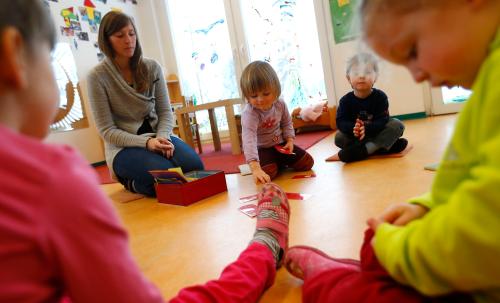This is the second post in the “Community Schools Leader Insights” series in which Brookings is sharing the experiences of people in the thick of community schools and who are making strides toward student success through the unique strengths of the local community.
“Our schools weren’t created for our students of color, students that are experiencing homelessness, or students with housing issues. So, what are we going to do to work with our partners to make sure that our students can still excel at high levels?”
– Superintendent
Tornadoes. Floods. School closures. A history of inequity and lack of investment. And two years ago, the start of a global pandemic. Leaders of Metro Nashville Public Schools (MNPS) and their community didn’t have to face these challenges alone—they had a strategy in place to mobilize their community through well-established partnerships built on trust and years of working together. When the pandemic hit, MNPS and their community school partners were able to provide students and families with food, books, diapers for families with young children—along with other necessities. They ensured continued support in a time of uncertainty.
With 34 established community schools, MNPS’s superintendent (a former community school principal) is now using federal recovery funds to invest in 26 new community schools and deepen the transformative work that the pandemic jumpstarted. Community schools work in partnership with community organizations, families, and other agencies to advance student outcomes by integrating student supports, active family and community engagement, collaborative leadership practices, and expanded and enriching learning time.
According to Alison McArthur, the district’s director of Community Achieves (the district department that manages community schools implementation), their approach is “about strategic alignment, partner support, academic enrichment, tutoring, extended learning, attendance initiatives, basic needs, and school culture.” The community school initiative focuses on supporting students to help them thrive. Alison adds, “We view this as a strategy for student success.”
Such a strategy requires intentional and focused leadership. Superintendents have taken on unexpected leadership roles over the past two years under extremely difficult circumstances. They became decisionmakers about public health, participated in political battles over masking and school reopening, engaged the community in how to spend recovery funds to meet the most pressing needs, and addressed staffing shortages—all while continuing the responsibilities that they were trained for, such as budgeting, instructional decisionmaking, and building a central office team. The urgency and complexity of the situation has taken a toll—many superintendents from the largest districts are leaving while many others are considering a change.
At the same time, superintendents recognize the need to take a comprehensive approach to recovery, to understand the lived realities of students both inside and outside of the school building. According to an analysis of a survey of superintendents on American Rescue Plan funding, the School Superintendents Association (AASA) found that superintendents identified funding priorities that included, “expanding whole child supports, including social, emotional, mental, and physical health and development.” The analysis continues to say that the association expects that districts will focus on these whole child investments “well beyond the [American Rescue Plan] ARP expenditure timeline of 2024.”
These investments require an organizing strategy.
The need for a community schools strategy
While programs and services to support the whole child are an obvious response to the volatile and inequitable impacts of COVID-19, many superintendents aren’t prepared for how to get partners and families—the strength of our communities—to work together in a strategic way.
Earlier this year, AASA convened a group of its members at its annual National Conference on Education to talk about community schools. Specifically, superintendents discussed what they already knew about the strategy, about their communities’ enduring and emerging needs, and about how to create sustainable and impactful districtwide initiatives to meet their goals.
The superintendents came from mostly small districts with student populations ranging from nearly 38,000 to fewer than 600. Most superintendents represented smaller districts—usually less than 10,000 students—too often left out of policy discussions.
Regardless of size or geography, the superintendents spoke about shared challenges in addressing hunger, housing insecurity, the opioid epidemic, the pandemic, and the ongoing impacts of systemic poverty and racism. They wanted to learn about strategic partnerships that could tap into new and existing resources.
All described some measure of partnership with their community, such as nonprofits, churches, or organizations like United Way (though these types of organizations were often limited in the smallest districts), that could connect them to additional resources. As one superintendent said, “I’ve seen it [partnerships] done differently in different districts. I can tell you, everybody has a different methodology of how to have partnerships.” Superintendents overwhelmingly wanted to learn more about the best transformational practices of community schools.
A few common themes and questions emerged from the discussion:
- Uncertainty about the role of community schools and their goals. Superintendents had basic knowledge about community schools but weren’t clear on a definition. They described variation even within their own states on how community schools are understood. What is the focus of community schools—integrating services, improving academics, or both?
- The changing role of schools. Superintendents noted that the pandemic and other changes across society have made them reconsider the role of schools. One leader noted that perhaps schools need to change, saying, “We have to redefine what schools are.” With increased need in our communities—from health to hunger—should schools be the place where services are delivered? Are they prepared for this changing role? Who are the partners required and how are they organized?
- Alignment with leadership and district goals. Naturally, leaders of districts wanted to ensure that partners are aligned with their district’s goals. What are the strategies for alignment within district offices and across community institutions?
- How do districts strategically mobilize partners? Leaders, especially in smaller districts, reflected concern about having the systems-level infrastructure, including human capital, to support community schools. What tools, funding supports, and examples are available for leaders to learn from?
Currently, there is a historic opportunity for district leaders to start and sustain community schools at a systems level. Community schools are becoming more accepted as a transformational strategy and funding has also increased. The White House and U.S. Department of Education continue to lift up community schools. There are $75 million new federal dollars for a community schools grant program just approved by Congress; states such as California, Maryland, and New York have statewide community school grants (with California starting a groundbreaking $3 billion grant program); and community schools may be used with the substantial recovery funds created by Congress.
Superintendents need a strategy to organize resources, authentically engage the community, leverage existing assets, and meet the needs of students and the community. They told us that they want to understand what community schools are and how to strategically use them and other funding opportunities to transform education systems. This is why the work of the Community Schools Forward task force will help provide this type of guidance and will be so welcomed by superintendents across the country.
The Brookings Institution is committed to quality, independence, and impact.
We are supported by a diverse array of funders. In line with our values and policies, each Brookings publication represents the sole views of its author(s).








Commentary
Community schools can help superintendents transform education
Community Schools Leader Insights
April 18, 2022